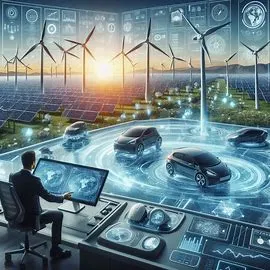Introduction to AI in Energy Management
Advancements in artificial intelligence (AI), smart grid technologies, and renewable energy integration are reshaping the global energy sector. As we look forward to 2024-2025, it is crucial to understand the latest statistics, emerging trends, best practices, and successful implementation case studies that will define this transformation.
Analyzing Key Components
AI in the Energy Sector AI technologies are playing an increasingly pivotal role in the energy sector by enhancing efficiency, reliability, and dependability in various applications:
Forecasting and Optimization:
- AI is extensively used for forecasting renewable energy generation, particularly for wind and solar power systems. By analyzing weather forecasts, historical generation data, and real-time conditions, AI algorithms improve the accuracy and reliability of renewable energy production, which is critical for integrating variable energy sources into the grid.
Maintenance and Operational Efficiency:
- AI identifies potential mechanical issues in wind turbines well before they cause failures, mitigating problems early, saving maintenance costs, and optimizing system performance.
Smart Grid Optimization The advent of smart grid technology is revolutionizing the power distribution network by enabling a more resilient, efficient, and sustainable grid:
Enhanced Monitoring and Management:
- Smart grids incorporate two-way communications and distributed intelligent devices, allowing real-time monitoring and control. This capability supports renewable energy integration, enhances grid stability, and offers consumers real-time control over their energy consumption.
Emerging Technologies:
- Innovations like the Internet of Energy (IoE), energy management systems (EMS), 5G connectivity, and blockchain are central to smart grid advancements. These technologies facilitate real-time data collection, energy asset monitoring, and secure data exchanges, thereby improving the overall efficiency and reliability of the grid.
Renewable Energy Integration The integration of renewable energy sources like wind and solar into the grid is crucial for reducing reliance on fossil fuels and achieving sustainability goals:
Growing Adoption:
- The global AI in the energy sector market is projected to reach $7.78 billion by 2025. Increasing adoption of predictive analytics tools by utilities drives this growth, helping them improve electricity generation and distribution by forecasting peak energy demand.
Government Initiatives:
- In the United States, the projected increases in wind capacity to 153.8 GW and solar capacity to 128.2 GW by the end of 2024 highlight the significant role of governmental policies and incentives in fostering renewable energy adoption.
Identifying Relevant Patterns
Case Studies on Successful Implementations
Frequenz’s AI-Powered Microgrid OS:
- German startup Frequenz developed Frequency EDGE AI, which uses AI to provide actionable insights for more efficient power management. Its open-source nature allows for localized adjustments, ensuring optimized functionality for specific microgrid requirements.
Solstice AI’s Energy Forecasting:
- Australian startup Solstice AI’s platform uses AI to offer accurate energy forecasts. By leveraging satellite imagery and socio-demographic data, Solstice AI improves the integration of renewable energy sources and grid stability.
Switch Electric’s Smart Meter:
- Nigerian startup Switch Electric’s prepaid smart meter and companion app facilitate real-time energy monitoring and remote management. This technology enables substantial improvements in grid reliability and consumer energy management.
Evaluating Potential Solutions
Best Practices for Future Implementations
Diversifying Energy Sources:
- Emphasizing a mix of renewable sources like wind, solar, and hydropower can mitigate the dependency on any single energy source and enhance grid stability.
Leveraging Energy Storage Solutions:
- Using grid-scale batteries and pumped hydro-storage can address the intermittency of renewable energy sources, ensuring a more stable and reliable energy supply.
Deploying Smart Grid Technologies:
- Implementing technologies like IoE, AI-powered EMS, and 5G connectivity will enable more efficient energy distribution, real-time monitoring, and proactive maintenance.
Investing in Microgrids and Distributed Energy Resources (DERs):
- Smaller, localized energy systems such as microgrids can improve resilience, provide backup during outages, and facilitate the integration of renewable energy.
Addressing Ambiguities
While the predictions and trends emphasize significant advancements, several factors could influence their actual implementation:
Regulatory and Policy Framework:
- Evolving regulations and support policies will play a crucial role in determining the pace of AI and renewable energy integration.
Technological Evolution:
- Rapid technological advancements may introduce new methods and tools, reshaping current predictions and trends.
Conclusion
The integration of AI, smart grid technologies and renewable energy is set to transform the energy sector by 2025. With the anticipated growth in AI-driven energy management solutions and smart grids, coupled with substantial increases in renewable energy capacities, the global energy landscape is moving towards a more sustainable and efficient future. Adopting best practices and learning from successful implementations will be critical in achieving these advancements.
Potential Follow-Up Exploration
Impact of Emerging Technologies:
- Investigate how new technologies, such as quantum computing or advanced battery storage, might further influence energy management and smart grid optimization.
Comparative Analysis:
- Perform a comparative analysis of different countries or regions to understand how varying regulatory environments and economic conditions impact AI and renewable energy adoption.





0 Comments